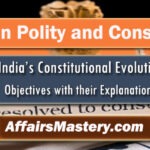Comprehensive Indian Constitutional Articles and Schedules MCQs | Set 1
Unlock Your Knowledge: Comprehensive and Important MCQs on Indian Constitution Articles and Schedules. Articles and Schedules plays a huge role in shaping Indian Polity and Governance, and it’s one of those things that really lays the groundwork for doing well in competitive exams—whether it’s Civil Services, State exams, SSC, Railways, Banking, or any of the others out there.
Diving deep into Indian Polity, Constitution, and governance isn’t just about memorizing facts or ticking boxes for exams, but more about developing the kind of awareness that can make navigating these challenging exams a little less overwhelming and a lot more manageable.
| MCQs on Indian Constitution Articles and Schedules – Objective Questions and Answers |

Q1. Indian Constitution consists of – (42nd B.P.S.C. (Pre) 1997)
[A] 300 Articles
[B] 350 Articles
[C] More than 400 Articles
[D] 500 Articles
View Explanation
Correct Answer is C.
- When the Indian Constitution was first adopted, it had 395 Articles, which were neatly divided into 22 Parts and included 8 Schedules as well.
- But over the years, with all the amendments and changes made to it, that number has grown, and now, it actually has more than 400 Articles.
- It keeps evolving, and different amendments have added new provisions, making it bigger than what it originally was.
Q2. How many parts, Articles and Schedules was there in the original Indian Constitution? (Jharkhand P.C.S. (Pre) 2016)
[A] 22 Parts, 395 Articles and 8 Schedules
[B] 24 Parts, 450 Articles and 12 Schedules
[C] 22 Parts, 390 Articles and 8 Schedules
[D] 24 Parts, 425 Articles and 12 Schedules
View Explanation
Correct Answer is A.
- When the Indian Constitution was first adopted on 26th November 1949, and came into effect on 26th January 1950, it originally had 22 Parts, 395 Articles, and 8 Schedules.
- Over the years, many amendments have been made, adding more Articles and Schedules, but in its original form, these were the numbers.
Q3. How many States and Union Territories were established by the 1956, State Restructuring Act? (M.P.P.C.S. (Pre) 2020)
[A] 14 States, 6 Union Territories
[B] 18 States, 9 Union Territories
[C] 22 States, 8 Union Territories
[D] 21 States, 7 Union Territories
View Explanation
Correct Answer is A.
- The States Reorganisation Act of 1956 was a major step in reshaping India’s internal boundaries.
- Before this, states were mainly divided based on historical and administrative factors, but the act reorganized them on linguistic lines to address regional and cultural demands.
- When this act came into effect on 1st November 1956, it led to the creation of 14 States and 6 Union Territories.
- This restructuring was one of the most significant changes in India’s administrative framework, ensuring a more organized and manageable state structure.
Q4. Total number of Schedules in the Constitution is – (M.P.P.C.S. (Pre) 1990)
[A] 12
[B] 16
[C] 8
[D] 10
View Explanation
Correct Answer is A.
- Originally, the Indian Constitution had 8 Schedules, but with time, amendments added more.
- The First Amendment in 1951 introduced changes, but the biggest additions came through later amendments.
- By the 42nd Amendment (1976) and later changes, the number of Schedules increased to 12.
- As of now, the Constitution contains 12 Schedules, each dealing with different aspects like allocation of powers, administration, and other governmental functions.
Q5. Consider the following statements: (I.A.S. (Pre) 2005)
1. The Constitution of India has 20 parts.
2. There are 390 Articles in the Constitution of India in all.
3. Ninth, Tenth, Eleventh and Twelfth Schedules were added to the Constitution of India by the Constitution (Amendment) Acts.
Which of the statements given above is/are correct?
[A] 1 and 2
[B] 2 only
[C] 3 only
[D] 1, 2 and 3
View Explanation
Correct Answer is C.
“Ninth, Tenth, Eleventh, and Twelfth Schedules were added by Constitutional Amendments.”
- Ninth Schedule was added by the First Amendment Act (1951).
- Tenth Schedule (Anti-Defection Law) was added by the 52nd Amendment (1985).
- Eleventh Schedule (Panchayati Raj) was added by the 73rd Amendment (1992).
- Twelfth Schedule (Municipalities) was added by the 74th Amendment (1992).
Q6. Consider the following statements : (I.A.S. (Pre.) 2018)
1. The Parliament of India can place a particular law in the Ninth Schedule of the Constitution of India.
2. The validity of a law placed in the Ninth Schedule cannot be examined by any court and no Judgement can be made on it.
Which of the statements given above is/are correct?
[A] 1 only
[B] 2 only
[C] Both 1 and 2
[D] Neither 1 nor 2
View Explanation
Correct Answer is A.
“The Parliament of India can place a particular law in the Ninth Schedule of the Constitution of India.”
- The Ninth Schedule was added by the First Amendment Act (1951) to protect certain laws (mainly land reforms) from judicial review.
- Parliament has the power to place laws in the Ninth Schedule through a constitutional amendment under Article 368.
“The validity of a law placed in the Ninth Schedule cannot be examined by any court and no judgment can be made on it.”
- Initially, laws placed in the Ninth Schedule were beyond judicial review, meaning courts couldn’t challenge them.
- However, in the landmark I.R. Coelho case (2007), the Supreme Court ruled that laws placed in the Ninth Schedule after 24th April 1973 (the date of the Kesavananda Bharati case) can be reviewed by courts if they violate the Basic Structure of the Constitution.
Q7. The Indian Constitution is divided into – (U.P. P.C.S. (Mains) 2012)
[A] 16 Parts
[B] 22 Parts
[C] 24 Parts
[D] 25 Parts
View Explanation
Correct Answer is B.
- Originally, when the Indian Constitution came into effect on 26th January 1950, it was divided into 22 Parts.
Q8. Which part of Constitution contains provisions relating to citizenship? (U.P.U.D.A./L.D.A. (Spl) (Mains) 2010)
[A] Part I
[B] Part III
[C] Part II
[D] Part IV
View Explanation
Correct Answer is C.
- Part II of the Indian Constitution (Articles 5 to 11) deals with the provisions relating to citizenship.
Q9. Which one of the following is not matched correctly? (U.P. Lower Sub. (Pre) 2004)
[A] Citizenship- Part II of Constitution
[B] Fundamental Rights- Part III of Constitution
[C] Fundamental Duties- Part VI-A of Constitution
[D] State- Part VI of Constitution
View Explanation
Correct Answer is C.
- Fundamental Duties are mentioned in Part IV-A of the Indian Constitution, not Part VI-A.
- These were added through the 42nd Amendment Act of 1976 under Article 51A.
Q10. Match List-I with List-II and select the correct answer from the code given below: (U.P. Lower Sub. (Mains) 2015)
| List – I | List – II |
| A. Formation of new states | 1. Part 2 |
| B. Citizenship | 2. Art. 3 |
| C. Fundamental Rights | 3. Art. 323-A |
| D. Setting of Administrative Tribunals | 4. Part 3 |
[A] A-2 B-1 C-4 D-3
[B] A-1 B-2 C-3 D-4
[C] A-3 B-4 C-1 D-2
[D] A-4 B-2 C-2 D-3
View Explanation
Correct Answer is A.
- Formation of new states (Article 3): It empowers Parliament to create or alter state boundaries.
- Citizenship (Part II): Defines who is considered an Indian citizen at the commencement of the Constitution.
- Fundamental Rights (Part III): Guarantees essential rights like equality, freedom, and protection against exploitation.
- Setting up of Administrative Tribunals (Article 323-A): Allows Parliament to establish tribunals for resolving disputes related to public services.



